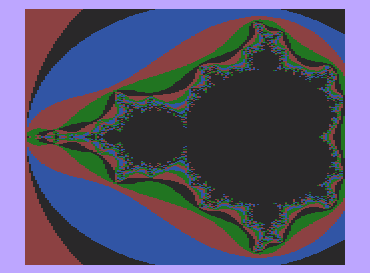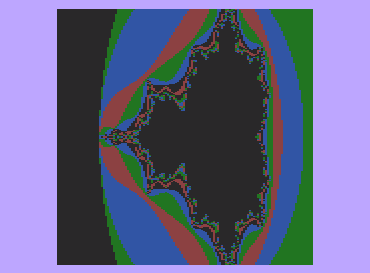Superfast Mandelbrot generator v10
It is based on an algorithm published on pouet in 2021. It uses 4 colors and flashing (or quasi-interlacing) to simulate 10 (or 16) colors. Generated pictures are 128x256 raster images. It is very likely that this algoritm implementation is the fastest known Mandelbrot set computation routine for the 6502.
The prg-file for the flashing variant is here and the prg-file for the quasi-interlaced variant is here.
There are also a fullscreen (160x256, v9) flashing variant and quasi-interlased variant – both compute 160x256 Mandelbrot dots.
The fullscreen variants are capable to generate up to 160x280 pictures but not every monitor may show so many raster lines. But if you need more lines just recompile the sources with proper parameters.
Maybe the most interesting is a fullscreen interactive (160x256, v5) variant – it computes and shows 160x256 Mandelbrot dots in 2/4/8/16 colors using interlacing or flashing. Let's observe several screenshots for the next Mandelbrot set parameters: x in [-2, .5], y in [-1.3, 1.3], iterations = 31. It is also possible to generate up to 160x280 pictures, again just compile the sources with proper parameters.
| True Colors | |
|---|---|
 2 colors |  4 colors |
| Flashing | |
 4 colors, 8 pseudocolors |  4 colors, 16 pseudocolors |
| Quasi-interlasing | |
 4 colors, 8 pseudocolors |  4 colors, 16 (10) pseudocolors |
| Quasi-interlasing, 280 raster lines | |
 4 colors, 16 (10) pseudocolors | |
The whole bundle can be taken on a zipped d64-image.
Sources are available on github.
There is also a small demo (sources) based on these sources.


